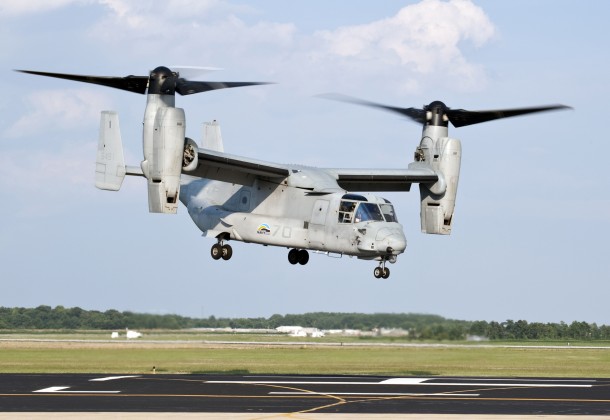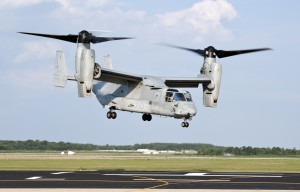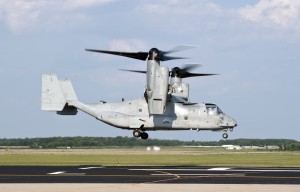Osprey Hovers on Biofuel


A U.S. Marine Corps MV-22 Osprey lifts off from Naval Air Station Patuxent River, during a successful biofuel test flight. The tilt-rotor aircraft flew at altitudes of up to 25,000 feet on a 50-50 blend of camelina based biofuel and standard petroleum based JP-5 fuel. (U.S. Navy photo)
By NAWCAD Public Affairs
The Navy and Marine Corps team reached another milestone toward achieving the Secretary of the Navy’s energy goals by successfully flying a Marine Corps MV-22 Osprey on biofuel Aug. 10 at Naval Air Station Patuxent River, Md.
“This is the first Marine Corps and tilt rotor aircraft to fly on biofuels,” said Navy Secretary Ray Mabus. “This brings us one step closer to reducing our dependence on foreign oil and becoming more energy secure and independent.”
The “Blackjacks” of Air Test and Evaluation Squadron (HX) 21 flew the tilt rotor aircraft at altitudes of up to 25,000 feet on a 50/50 blend of camelina based and standard petroleum based JP-5 (aviation) fuel. The camelina sativa plant is a U.S. grown, non-food feedstock plant.
The MV-22 is a multi-mission aircraft, flown by the Marine Corps, and combines the functionality of a helicopter with the long range and high speed of a turboprop aircraft.
 “As these types of biofuel certification tests continue on the Osprey and other aircraft, we continue to make steady progress toward the energy goals I laid out in October 2009,” said Mabus. “Those goals are aimed first at improving our warfighting capability and reducing our vulnerabilities, but they will also increase our energy efficiency and help lead the nation toward a clean energy economy.”
“As these types of biofuel certification tests continue on the Osprey and other aircraft, we continue to make steady progress toward the energy goals I laid out in October 2009,” said Mabus. “Those goals are aimed first at improving our warfighting capability and reducing our vulnerabilities, but they will also increase our energy efficiency and help lead the nation toward a clean energy economy.”
“The MV-22 testing builds upon our successful test flights of the F/A-18 E/F Super Hornet, F/A-18 C/D legacy Hornet, MH-60S Seahawk as well as extensive testing in the Navy’s Patuxent River fuels lab in demonstrating that Navy and Marine Corps aircraft can safely operate on fuel produced from renewable sources,” said Rick Kamin, the Navy Fuels lead.
For additional information about the Navy’s energy, environmental and climate change initiatives, please visit www.greenfleet.dodlive.mil.




















